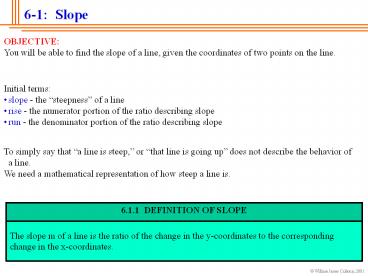6-1: Slope - PowerPoint PPT Presentation
1 / 9
Title:
6-1: Slope
Description:
To find the slope, you first see how far the line rose going from (0, 0) to (5, 4) ... The slope is the first number over the second number. ... – PowerPoint PPT presentation
Number of Views:58
Avg rating:3.0/5.0
Title: 6-1: Slope
1
6-1 Slope
OBJECTIVE You will be able to find the slope of
a line, given the coordinates of two points on
the line.
- Initial terms
- slope - the steepness of a line
- rise - the numerator portion of the ratio
describing slope - run - the denominator portion of the ratio
describing slope
To simply say that a line is steep, or that
line is going up does not describe the behavior
of a line. We need a mathematical representation
of how steep a line is.
2
6-1 Slope
The mathematical definition of slope can be
written like this
In the picture on the right, the line runs
through the origin and the point (5, 4). To find
the slope, you first see how far the line rose
going from (0, 0) to (5, 4). To get from the
origin to (5, 4), you must go 4 units
upward. Second, how far did the line run to the
right? You must go 5 units to the right.
3
6-1 Slope
When finding the slope of a line from a graph,
look at two points (reading from left to right)
and ask
(1) how far did the line go up or down from left
to right, and (2) how far did the line go to the
right.
The slope is the first number over the second
number. Look at the lines in the following two
graphs
In one of the graphs, the line goes up from left
to right. In the other, the line goes down from
left to right. In math, we need a way to say
whether the line is rising up or down.
Lines with positive slopes go up from left to
right. (rise is positive) Lines with negative
slopes go down from left to right. (rise is
negative)
4
6-1 Slope
There is a formula that we use to find the slope
of any line if we know two points on that line.
You must utilize and/or memorize the formula to
make it through the rest of graphing. The formula
simply says what has been said before Slope is
how much the line went up/down by (reading from
left to right) over how much the line went to the
right by. Remember this Rise over Run - and
always run to the right.
5
6-1 Slope
EXAMPLE 1 Determine the slope of each
line. A. B. C. D.
We do not need the formula for these, although
the formula will work.
How much did y change? up 3 How much did x
change? right 2 Write the fraction of changes in
y over change in x m
How much did y change? up 4 How much did x
change? left 3, so -3 Write the fraction of
changes in y over change in x m
How much did y change? no up or down, so 0 How
much did x change? right 2 Write the fraction of
changes in y over change in x m 0
How much did y change? up 3 How much did x
change? no right/left, so 0 Write the fraction of
changes in y over change in x m (!!!)
6
6-1 Slope
That last part of Example 1 gave us a slope of
. This fraction has a zero in the denominator.
We know that you can never divide by zero. You
cannot break something up into no
pieces. Therefore, lines like those in EX 1D are
said to have no slope and are always vertical
lines.
In the first example we saw the four general
slopes of lines (1) Positive - the line goes up
and to the right. (2) Negative - the line goes
down and to the right. Again, always think of
running to the right which is not the way the
book did it in the example. (3) Zero-slope - the
line is horizontal. These lines will always be of
the form y . (4) No-slope - the line is
vertical. These lines will always be of the form
x .
The lines we will see in this class will always
be in one of the four categories above.
7
6-1 Slope
EXAMPLE 2 Determine the slope of the line that
passes through (2, -5) and (7, -10).
First step should be to label your points as x1,
x2, y1, and y2.
Second, plug those values into the formula for
slope
-5
-10
-1
2
7
Finally, simplify the expression.
Now for a new type of problem that uses the slope
formula, but not to find the slope.
8
6-1 Slope
(x1, y1)
(x2, y2)
Label what you know from the problem.
Cross-multiply.
Plug the known values into the slope formula.
Distribute.
Simplify.
Solve for r.
6
-3
-3(10 - r) 2(-9)
-30 3r -18
r
10
3r 12
r 4
9
6-1 Slope
HOMEWORK
Page 329 15 - 35 odd































